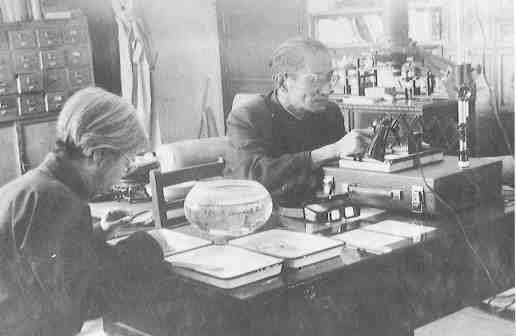One essential resource for studying—and teaching—Chinese culture is an excellent series from Wind Records 風潮公司 (Taipei), based on archive recordings of the Music Research Institute (MRI) in Beijing, many made amidst the constant campaigns of the first fifteen years of the PRC before the Cultural Revolution—the most authoritative overview of Chinese music on disc.
Four 2-CD sets (with booklets in Chinese) are devoted in turn to folk-song, narrative-singing, opera, and instrumental music:
- Tudi yu ge 土地與歌 [English title Songs of the land in China: labor songs and love songs] (1996).
Far from the kitsch arrangements that flood the market, these tracks—many recorded in the 1950s—are mostly unaccompanied, with work songs, songs of boatmen and foresters, love songs, wedding laments, passionate huar from Qinghai, and shan’ge from Shaanbei. Also featured are recordings from Hunan, Hubei, Guizhou, Sichuan, and Yunnan. - Shibaduan quyi 十八段曲藝 [Shuochang: the ultimate art of Chinese storytelling] (1998).
This collection of early recordings of narrative-singing includes drum-singing from Beijing and Tianjin, tanci from Suzhou, and less well-known examples from Henan, Gansu, Qinghai, Hubei, and Guangxi. See also my roundup of posts on narrative-singing. - Jinye lai changxi 今夜來唱戲 [The beauty of Chinese opera] (1998).
An overview of regional dramatic traditions, including not only Kunqu and Beijing opera (with Yu Zhenfei, Mei Lanfang, and others), but tracks from Hunan, Sichuan, northern “clapper” operas, as well as yangge opera and searing puppet drama from Shaanxi. - Xianguan chuanqi 弦管傳奇 [Special collection of contemporary Chinese musicians] (1996).
Complementing my 2-CD set on AIMP (also based on early MRI recordings), this set focuses on solo instruments, with some of the great masters from the 1950s. Apart from qin and zheng zithers (Zhao Yuzhai, Gao Zicheng, Luo Jiuxiang), pipa plucked lute, and various fiddles, there are also ensemble tracks led by dizi flute and suona shawm (from southwest Shandong), and guanzi oboe (Yang Yuanheng). The set ends with a drum section from the Shifan gu repertoire played in 1962 by the great Daoist master Zhu Qinfu.

Yang Yinliu and Cao Anhe at the MRI, 1961.
The series highlights the sterling work of the MRI under the great Yang Yinliu—to whom Wind Records also dedicated a 2-CD set. Of course audio recordings alone can’t encompass the complexities of changing social life, but basic familiarity with soundscape should be an essential aspect of our education in Chinese culture.
For a further CD-set in the series, see here; for more discography, see my article in The Rough Guide to world music; for films on rural and ritual life in China, click here; and for precious recordings from 1901–2, here. In the sidebar, note also my playlist, with commentary here.





Thanks for these interesting suggestions. Where does one access them from the UK? I’d be particularly interested in hearing Shibaduan quyi 十八段曲藝 [Shuochang: the ultimate art of Chinese storytelling] (1998), but the link doesn’t seem to have UK visitors in mind?
LikeLike
Indeed, the sets are even hard to find on their website http://www.windmusic.com.tw/en/. Hmm. Good luck googling further?! There’s always libraries, like SOAS…
LikeLike
Pingback: A 1956 fieldtrip to Hunan | Stephen Jones: a blog
Pingback: Hequ 1953: collecting folk-song | Stephen Jones: a blog
Pingback: Shadow puppets and Satie | Stephen Jones: a blog
Pingback: Images from the Maoist era | Stephen Jones: a blog
Pingback: Buddhism under Mao: Wutaishan | Stephen Jones: a blog
Pingback: Ritual life around Suzhou | Stephen Jones: a blog
Pingback: Uyghur culture in crisis | Stephen Jones: a blog
Pingback: A 2019 retrospective | Stephen Jones: a blog
Pingback: Coronavirus 2: songs from Gansu, and blind bards | Stephen Jones: a blog
Pingback: Precious recordings from imperial China | Stephen Jones: a blog
Pingback: Native American musical cultures 1 | Stephen Jones: a blog
Pingback: Ethnic polyphony in China | Stephen Jones: a blog
Pingback: Chinoperl | Stephen Jones: a blog – Dinesh Chandra China Story